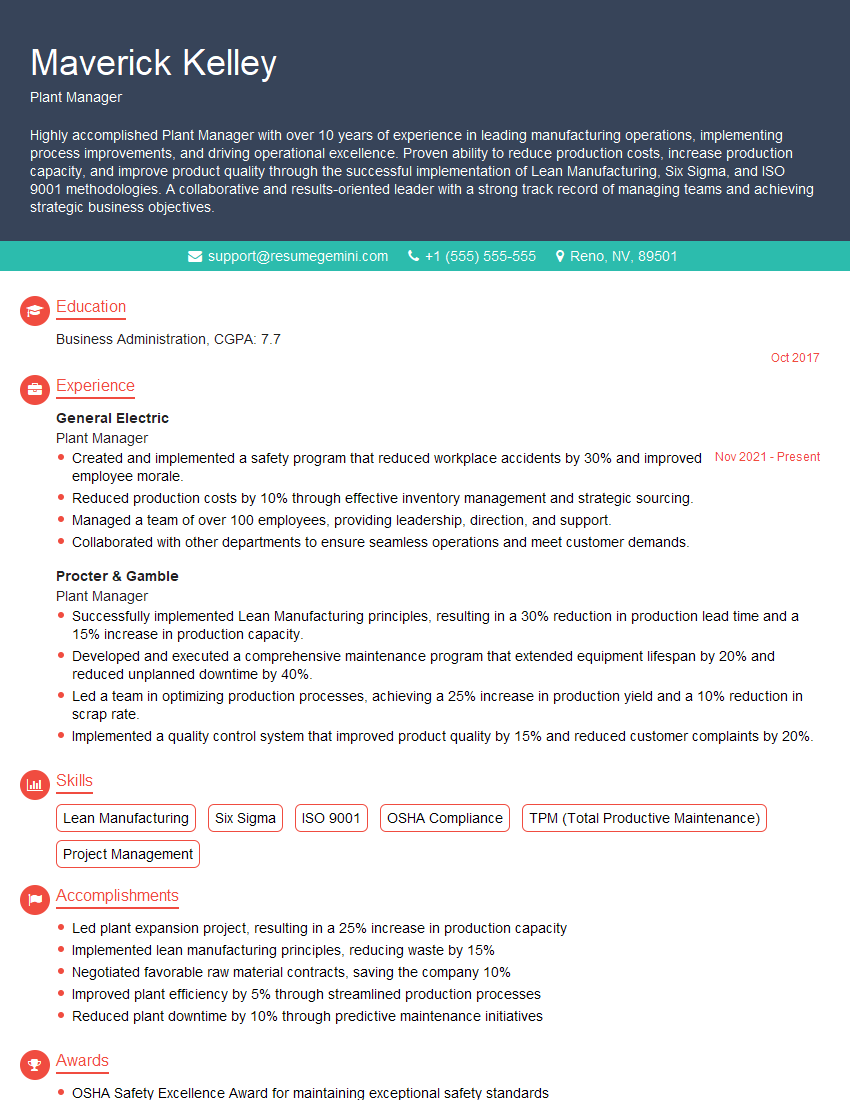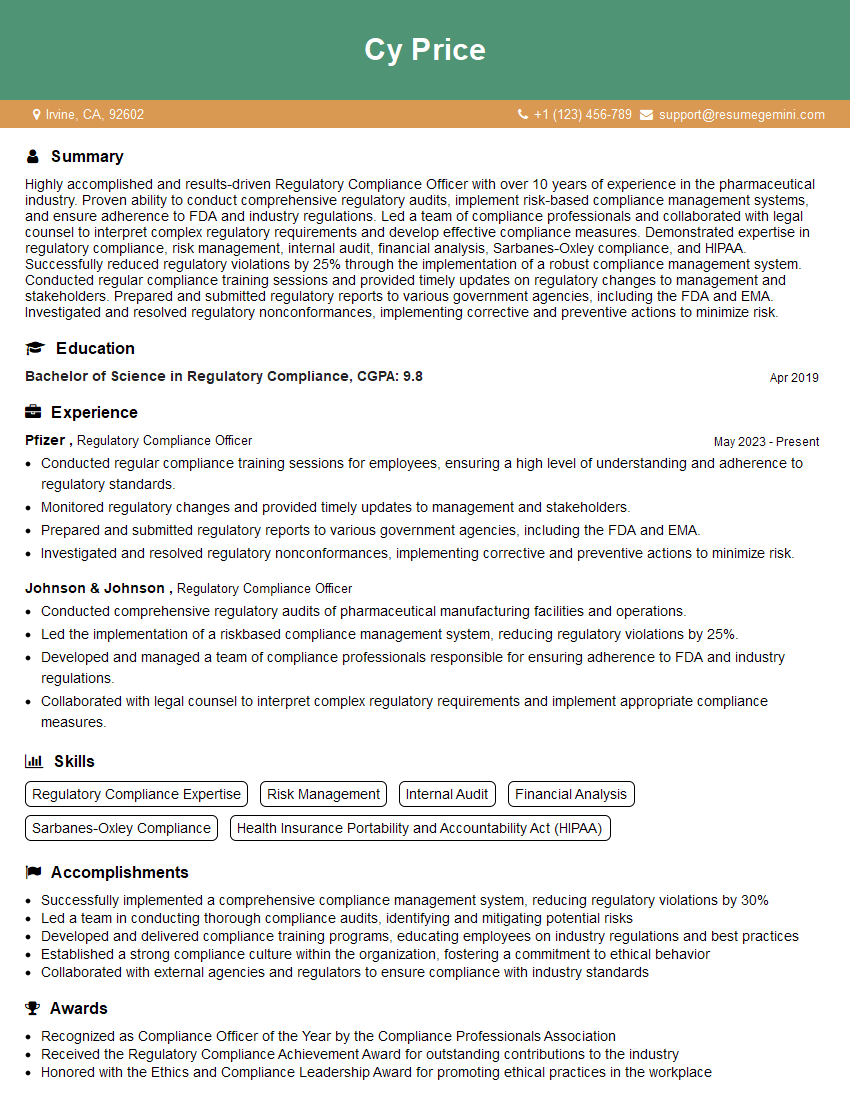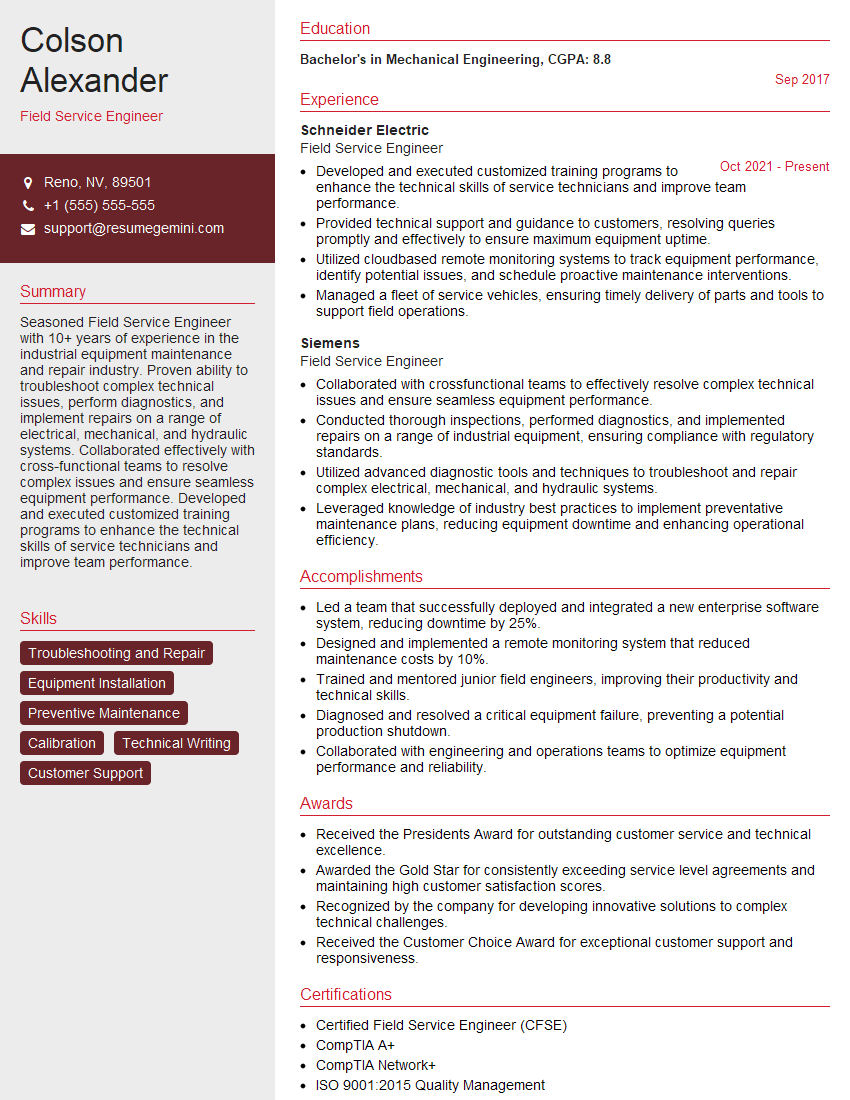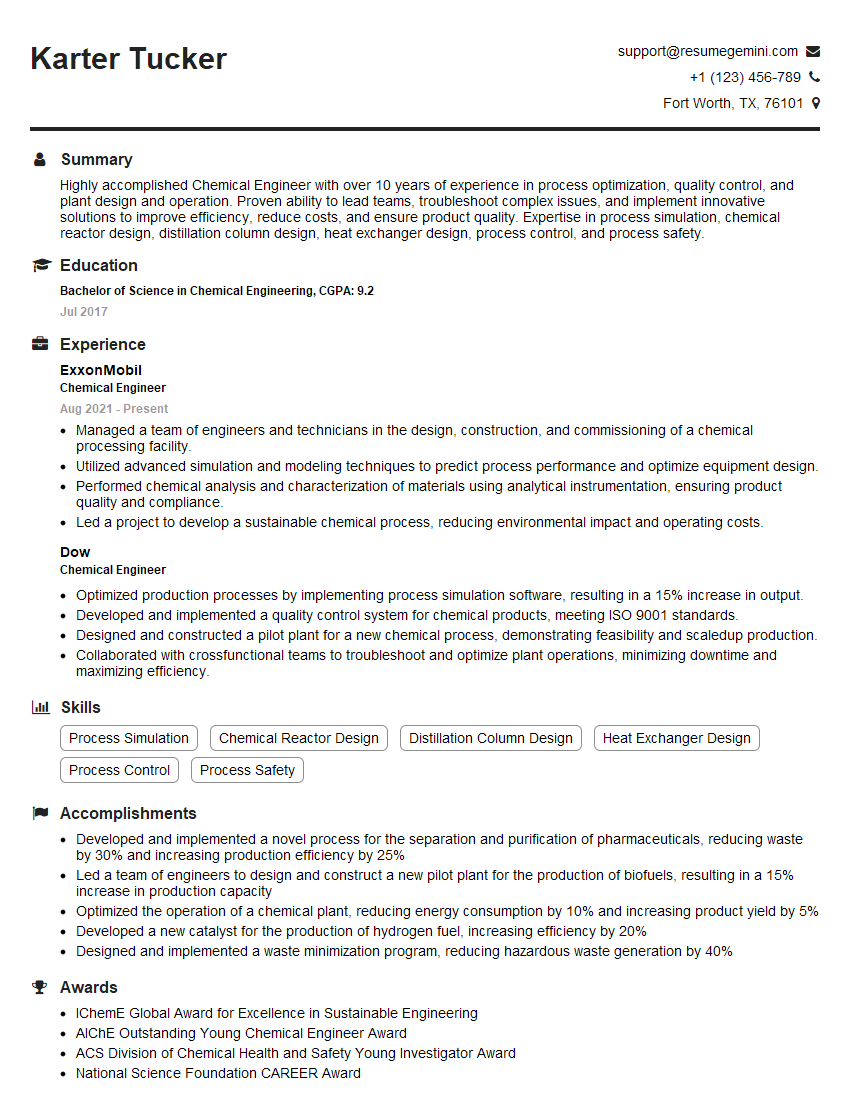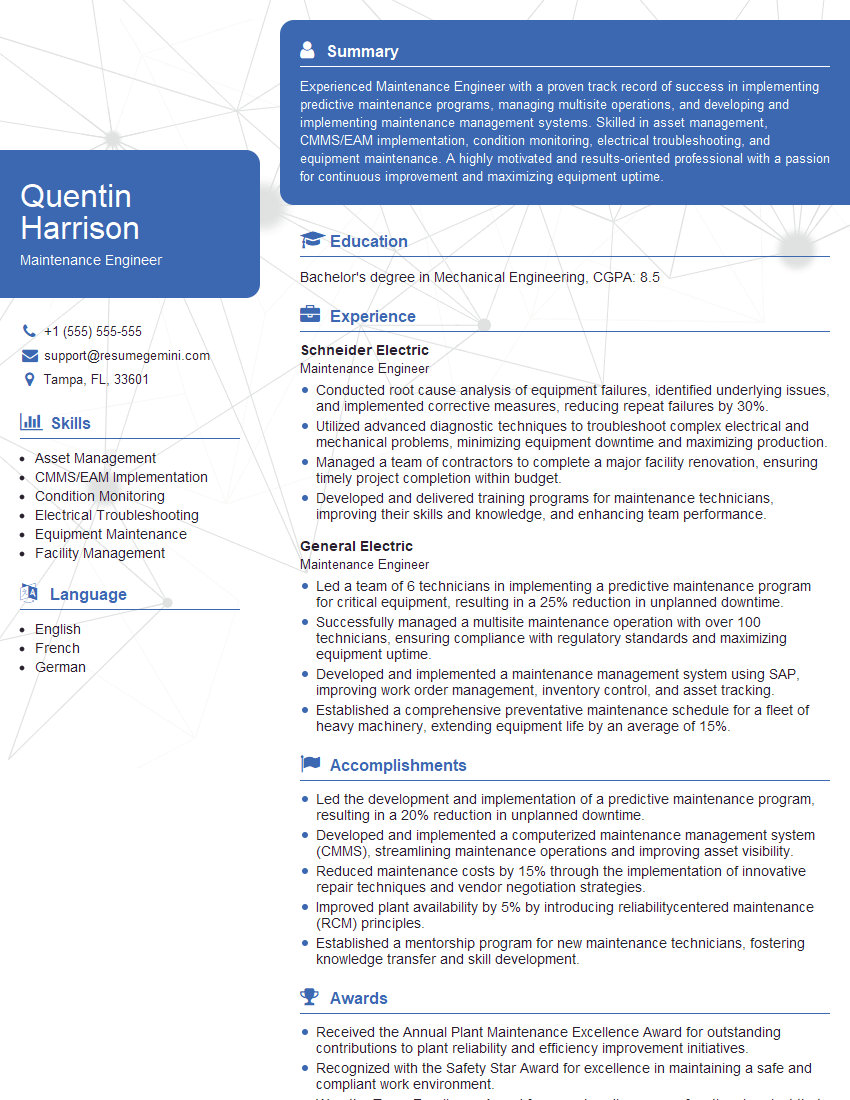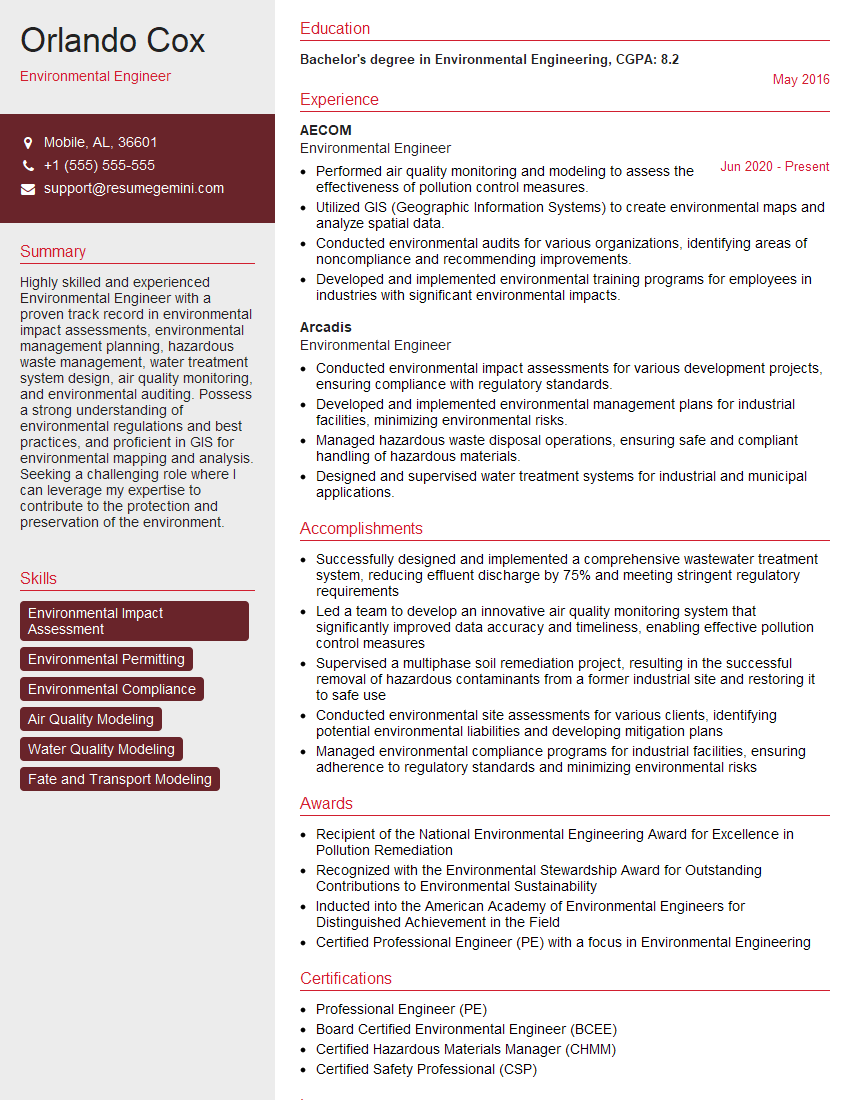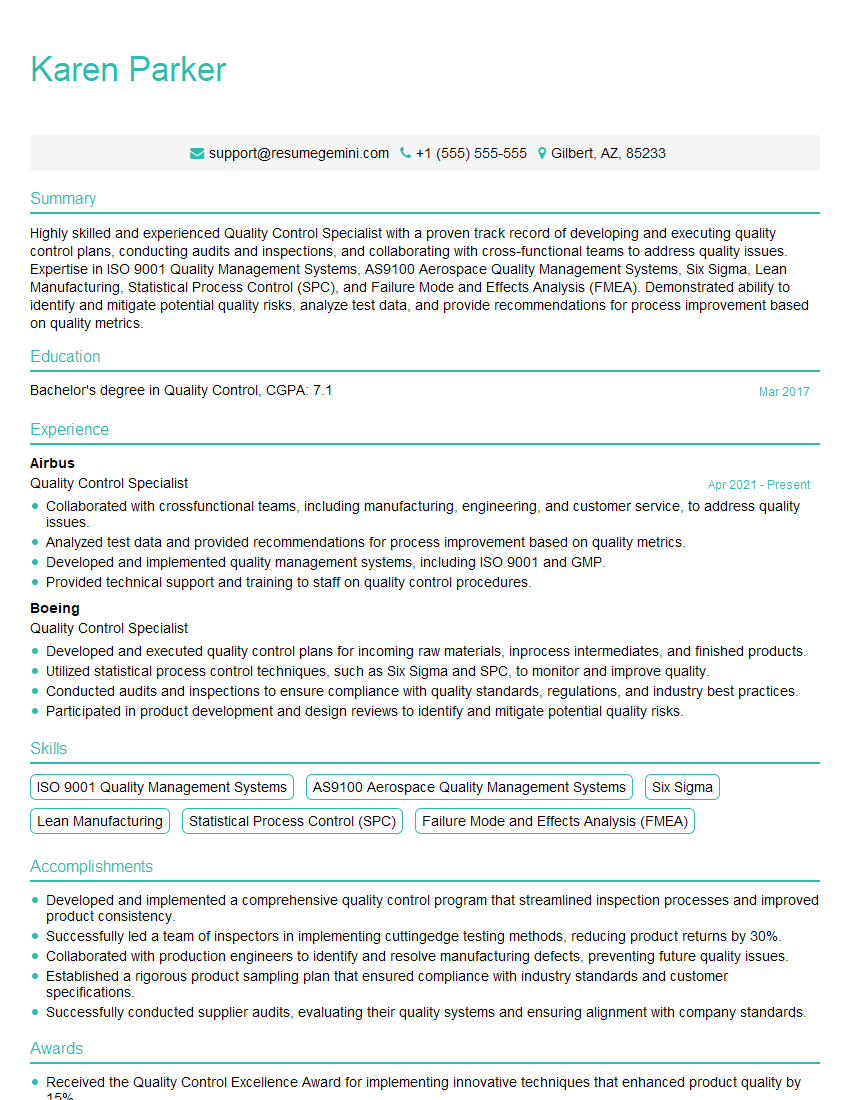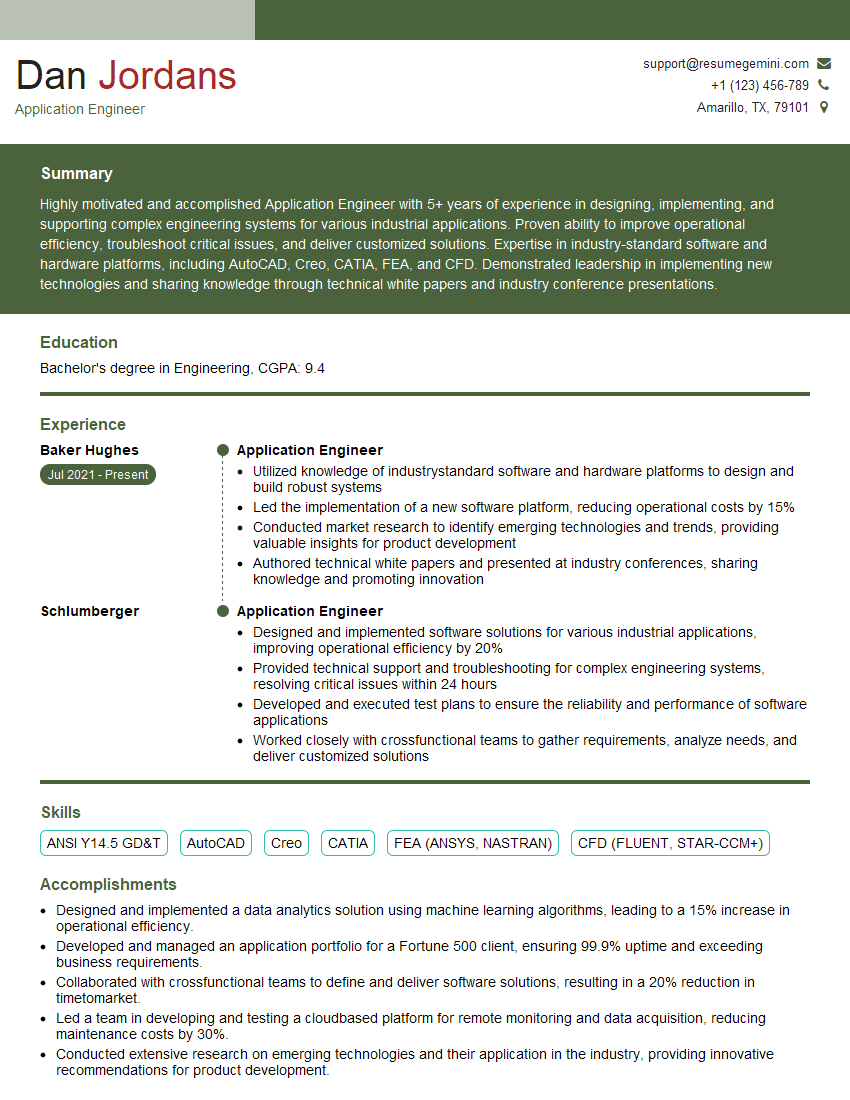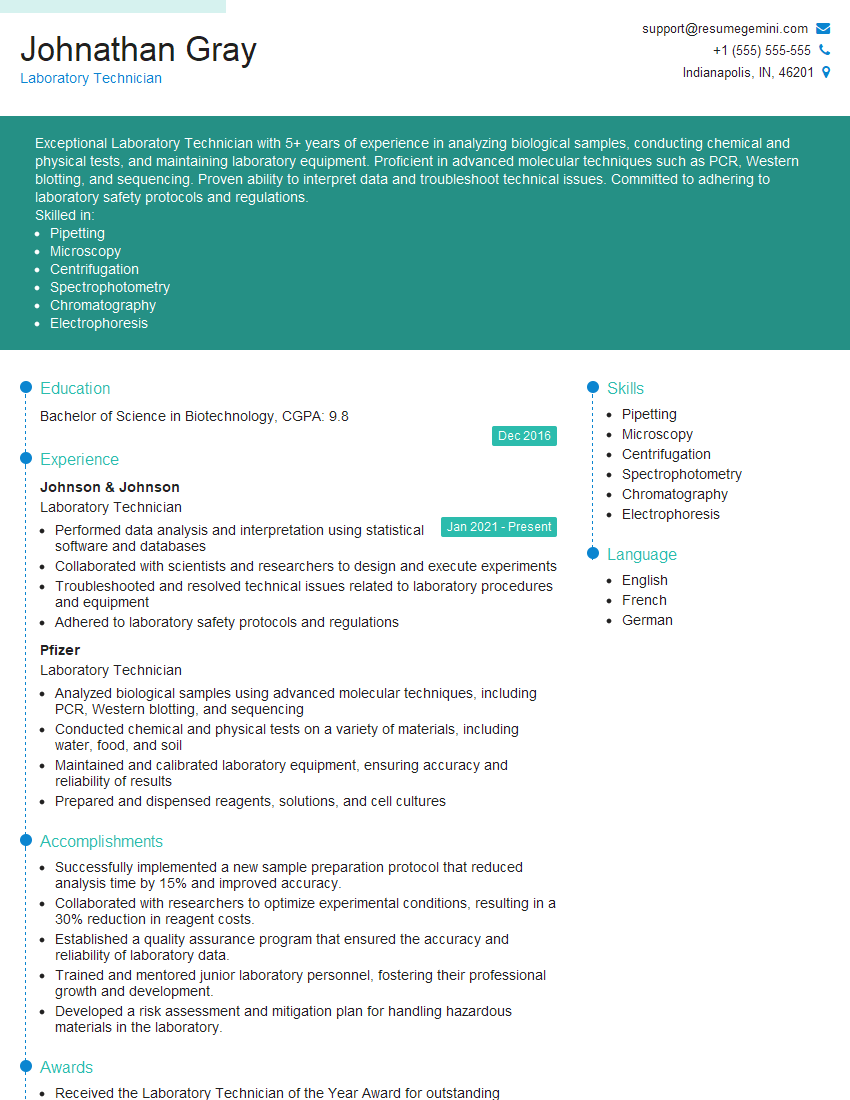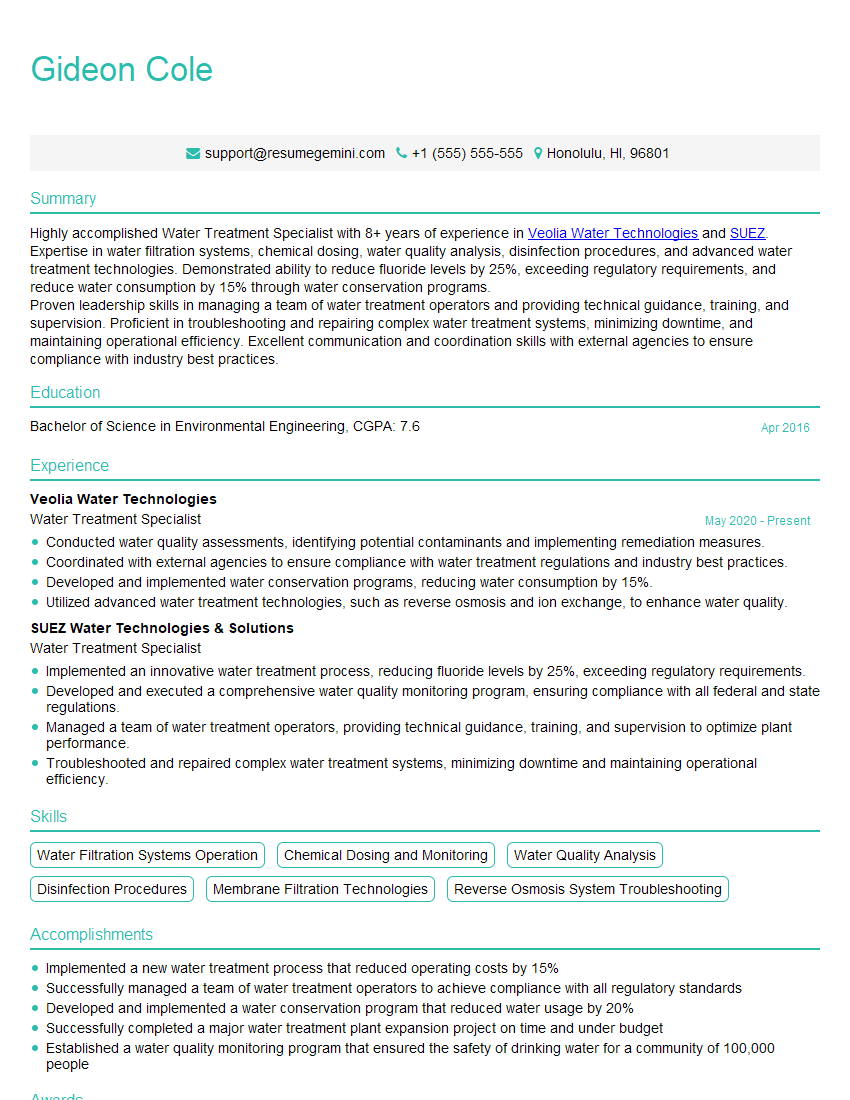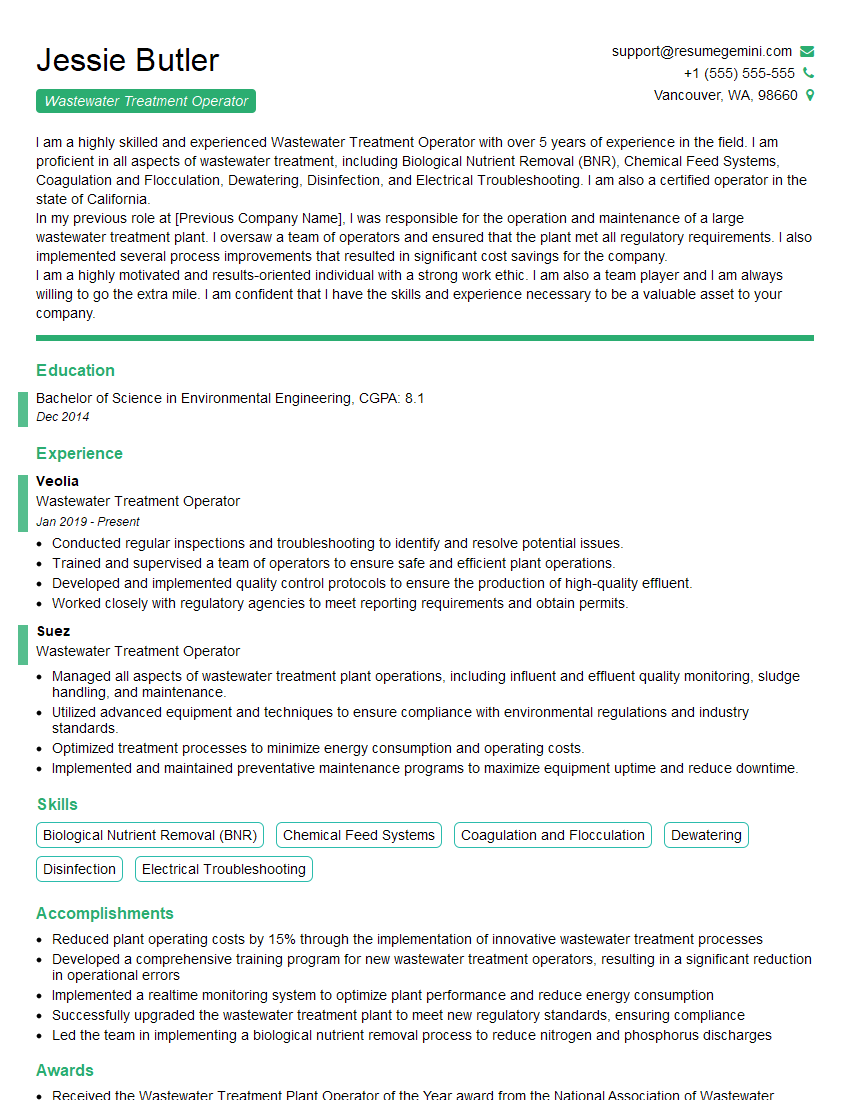Feeling uncertain about what to expect in your upcoming interview? We’ve got you covered! This blog highlights the most important Flocculation and Coagulation interview questions and provides actionable advice to help you stand out as the ideal candidate. Let’s pave the way for your success.
Questions Asked in Flocculation and Coagulation Interview
Q 1. Explain the difference between flocculation and coagulation.
Coagulation and flocculation are both crucial steps in water treatment aimed at removing suspended impurities, but they operate through different mechanisms. Think of it like this: coagulation is like gathering small dust particles together, while flocculation is like gluing those clumps into larger, easily-removable masses.
Coagulation involves adding a chemical coagulant, which neutralizes the electrical charges on the suspended particles (colloids). This neutralization reduces the repulsive forces between the particles, allowing them to come closer together. This process is rapid and occurs at a near-molecular level. Common examples of coagulants are aluminum sulfate (alum) and ferric chloride.
Flocculation, on the other hand, is a slower process that involves gently mixing the coagulated particles to encourage them to collide and form larger aggregates called flocs. These flocs are much larger than the individual particles and are easily removed through sedimentation or filtration. Flocculants, often polymeric substances, are sometimes added to aid in this aggregation process by bridging the gap between the smaller coagulated particles.
In essence, coagulation destabilizes the particles, while flocculation aggregates them into larger, settleable solids. They are sequential processes, with coagulation preceding flocculation in a typical water treatment plant.
Q 2. Describe the different types of coagulants and flocculants used in water treatment.
A wide range of coagulants and flocculants are available, each with its own characteristics and suitability for different water conditions.
- Coagulants:
- Aluminum sulfate (alum): A widely used, relatively inexpensive coagulant effective across a range of pH conditions.
- Ferric chloride: Another common choice, particularly effective at lower pH values. It forms stronger flocs than alum.
- Ferric sulfate: Similar to ferric chloride but often preferred in situations requiring less acidity.
- Polyaluminum chloride (PAC): A more advanced coagulant offering better performance in certain turbidity ranges and pH conditions.
- Flocculants:
- Polyacrylamide (PAM): A synthetic polymer available in different forms (anionic, cationic, non-ionic) to optimize performance depending on the characteristics of the suspended particles and the chosen coagulant. This is a highly versatile and widely used flocculant.
- PolyDADMAC: Another synthetic polymer commonly used as a primary or secondary flocculant.
- Natural polymers: Derived from sources like starch or chitosan, offering a more eco-friendly alternative in some applications.
The choice of coagulant and flocculant depends on various factors discussed in the next question.
Q 3. What factors influence the selection of a coagulant or flocculant?
Selecting the appropriate coagulant and flocculant is crucial for efficient water treatment. Several factors significantly influence this decision:
- Water quality: The type and concentration of impurities (turbidity, color, organic matter) in the raw water determine the effectiveness of different coagulants and flocculants. For instance, highly colored water may require a different approach than water with high turbidity.
- pH: The pH of the water impacts the effectiveness of many coagulants. Each coagulant has an optimal pH range for best performance. Alum, for example, performs best within a specific pH range.
- Temperature: Temperature affects the rate of coagulation and flocculation reactions. Lower temperatures often slow down the process.
- Cost: The cost-effectiveness of each chemical must be considered, balancing performance with budget constraints. Alum is generally less expensive than PAC or specialized polymers.
- Environmental considerations: The environmental impact of each chemical is also important. The choice might favor less harmful alternatives, especially if discharge regulations are strict.
- Existing infrastructure: The existing equipment and processes in the water treatment plant may limit the choice of coagulants and flocculants.
A comprehensive understanding of the raw water characteristics and treatment objectives is vital for optimal selection.
Q 4. How do you determine the optimal dosage of coagulant and flocculant?
Determining the optimal dosage of coagulant and flocculant is a critical step. Overdosing can lead to increased costs and potentially negatively impact water quality, while underdosing results in inefficient treatment.
The most common method is the jar test (described in the next question). This laboratory procedure allows for evaluating different dosages under controlled conditions. The optimal dosage is determined by finding the dosage that produces the largest, fastest-settling flocs with the clearest supernatant (the liquid above the settled solids).
Other methods include:
- Pilot plant studies: Larger-scale testing before implementing changes to full-scale operations.
- Mathematical modeling: Sophisticated models can predict optimal dosages based on water quality data and historical performance.
- Process control optimization: Modern water treatment plants often use online monitoring and automated control systems that adjust coagulant and flocculant dosages based on real-time water quality measurements.
The chosen method depends on the available resources, the complexity of the water treatment system, and the desired level of accuracy.
Q 5. Explain the jar test and its importance in water treatment.
The jar test is a simple yet powerful laboratory procedure used to determine the optimal coagulant and flocculant dosage. It simulates the coagulation and flocculation process in a series of jars, each containing a different coagulant dosage and a representative sample of the raw water.
Procedure:
- Several jars are filled with the raw water sample.
- Different dosages of the coagulant are added to each jar.
- The jars are rapidly mixed for a short period to ensure proper dispersion of the coagulant.
- Gentle mixing (flocculation) follows the rapid mix. The speed and duration are carefully controlled.
- The jars are allowed to settle for a specific time.
- The clarity of the supernatant (the liquid above the settled flocs) is visually assessed, and the size and characteristics of the flocs are observed.
Importance:
The jar test provides a rapid and cost-effective way to optimize the coagulation and flocculation process, minimizing chemical usage and maximizing treatment efficiency. It guides the selection and dosage of chemicals in the full-scale water treatment plant.
Q 6. Describe the different types of flocculation basins and their design considerations.
Flocculation basins are crucial components of water treatment plants, providing the controlled environment for floc formation. Several types exist, each with its own design considerations:
- Horizontal flow basins: Water flows horizontally through the basin, with gentle mixing provided by paddles or other mechanical devices. These are widely used and relatively simple to design and operate. Design considerations include ensuring uniform flow and sufficient residence time for effective flocculation.
- Vertical flow basins: Water flows vertically downwards through the basin. Mixing is often achieved through the introduction of water at various points. Vertical flow basins often occupy less space than horizontal ones but can be more challenging to design for uniform mixing.
- Lamella clarifiers: These utilize inclined plates or tubes to increase the settling area within a smaller footprint. They are efficient for space-constrained applications and offer faster settling rates. Careful design of the inclined plates is crucial to avoid short-circuiting and ensure uniform flow.
- Contact basins: Contact basins allow for the coagulation, flocculation, and sedimentation to occur in a single unit. This minimizes the footprint but requires careful design to manage the competing processes effectively.
Design considerations for all types include: residence time, mixing intensity, flow patterns, sludge removal mechanisms, and material selection (corrosion resistance and durability).
Q 7. What are the key parameters monitored during flocculation and coagulation?
Effective monitoring during coagulation and flocculation ensures efficient and reliable water treatment. Key parameters include:
- Turbidity: Measures the cloudiness of the water and provides an indication of the effectiveness of particle removal. A decrease in turbidity signals successful coagulation and flocculation.
- pH: Monitoring pH is crucial as it significantly impacts coagulant performance. Optimal pH control is essential.
- Coagulant and flocculant dosage: Precise monitoring of chemical additions ensures consistent dosing and prevents over or underdosing.
- Floc size and strength: The size and structure of the flocs influence settling efficiency. Visual observation and sometimes more advanced methods are employed.
- Residual coagulant: Measurement of residual coagulant in the treated water helps ensure compliance with regulatory limits.
- Sedimentation basin performance: Monitoring the solids loading and sludge blanket height in the sedimentation basins is crucial to manage sludge removal and prevent carryover of solids.
- Filtration performance: If filtration follows coagulation and flocculation, monitoring filter performance (e.g., head loss, effluent turbidity) is essential.
Regular monitoring and data analysis are necessary for optimizing treatment processes, troubleshooting issues, and ensuring high-quality treated water.
Q 8. How do you troubleshoot problems related to poor flocculation or coagulation?
Troubleshooting poor flocculation or coagulation involves a systematic approach. Think of it like diagnosing a car problem – you need to check various systems. First, we assess the raw water quality: high turbidity, unexpected organic matter, or unusual chemical composition can all impact flocculation. Next, we examine the chemical dosage and feed system: are we adding the correct amount of coagulant and flocculant? Is the chemical properly dissolving and mixing? Are there any blockages or malfunctions in the feed system? We then look at the mixing process: insufficient mixing in the rapid mix or slow mix tanks can lead to poor floc formation. Finally, we analyze the settling process: is the settling tank overloaded, are there issues with sludge removal, or is there insufficient settling time? A thorough investigation usually involves laboratory jar tests, which allow us to optimize coagulant dosages and mixing parameters at a smaller scale. For example, if jar tests show improved flocculation with increased coagulant dosage, we can implement that change in the full-scale system. In short, it’s a combination of systematic investigation, lab testing and process adjustment.
- Water Quality Analysis: Turbidity, pH, temperature, and organic matter.
- Chemical Dosage and Feed System Check: Verify correct dosage, dissolution, and equipment function.
- Mixing Optimization: Adjust rapid and slow mixing parameters.
- Settling Tank Evaluation: Assess tank capacity, sludge removal, and settling time.
- Jar Testing: Laboratory-scale optimization of coagulant and flocculant dosages, and mixing conditions.
Q 9. Explain the concept of zeta potential and its role in coagulation.
Zeta potential is the measure of the electrical charge on the surface of particles in a solution. Imagine each particle as a tiny magnet; the zeta potential represents the strength of this magnet. In coagulation, particles in water (like clay or algae) usually carry a similar surface charge, causing them to repel each other and remain dispersed. Coagulants, like ferric chloride or alum, neutralize this charge, reducing the zeta potential. When the zeta potential is close to zero (or the isoelectric point), the repulsive forces weaken, allowing particles to come closer and form larger aggregates. These larger aggregates, called flocs, are then easier to remove by sedimentation or filtration. The reduction in zeta potential is a crucial step in the destabilization of colloidal particles, facilitating the coagulation process. For example, if the zeta potential remains high after coagulant addition, it indicates that the coagulation process isn’t effective and more coagulant, or a different type, may be necessary.
Q 10. Describe the effect of pH on coagulation and flocculation.
pH plays a critical role in coagulation and flocculation. It affects the charge of both the particles and the coagulant. Different coagulants have optimal pH ranges for effective charge neutralization. Alum, for example, works best in a slightly acidic pH range (around 6-7), while ferric chloride is effective over a broader pH range. At inappropriate pH levels, the coagulant may not neutralize the particle charge effectively, leading to poor floc formation. A pH that’s too high or too low can also affect the solubility of the coagulant, reducing its effectiveness. For instance, at a very high pH, alum may precipitate out before it can effectively neutralize the charges on the particles. Therefore, pH control is crucial for efficient coagulation and flocculation and is often adjusted through the addition of acids or bases.
Q 11. What are the common challenges encountered during flocculation and coagulation processes?
Common challenges in flocculation and coagulation include:
- High Turbidity: High levels of suspended solids can overwhelm the coagulant, leading to poor floc formation and ineffective removal.
- Organic Matter Interference: Humic acids and other organic substances can consume coagulants, reducing their effectiveness.
- Inconsistent Water Quality: Variations in water characteristics (turbidity, pH, temperature) can make it difficult to maintain optimal coagulation conditions.
- Inappropriate Coagulant Selection: Choosing the wrong coagulant or flocculant for the specific water quality can result in poor performance.
- Insufficient Mixing: Inadequate mixing can prevent proper dispersion of the coagulant and floc formation.
- Overdosing or Underdosing of Coagulants: Both can lead to inefficient coagulation and poor floc settling.
- Equipment Malfunctions: Problems with pumps, mixers, or settling tanks can disrupt the process.
Q 12. How do temperature and turbidity affect coagulation and flocculation efficiency?
Temperature and turbidity significantly affect coagulation and flocculation efficiency. Lower temperatures generally slow down the chemical reactions involved in coagulation, leading to slower floc formation and potentially poorer settling. High turbidity means more suspended solids, requiring a higher coagulant dosage to achieve effective flocculation. Imagine trying to glue together a large number of small objects – it takes more glue (coagulant) and more time (lower temperature) compared to gluing together a few objects. Therefore, effective coagulation and flocculation processes often need adjustments in chemical dosages based on the water temperature and turbidity. For instance, a cold water treatment plant might require a slightly higher coagulant dose compared to a warm water plant to achieve the same level of solids removal.
Q 13. Explain the role of mixing intensity in flocculation.
Mixing intensity is crucial for efficient flocculation. It’s a two-stage process: rapid mix and slow mix. Rapid mix provides rapid and intense mixing to ensure the coagulant is dispersed quickly and uniformly throughout the water, facilitating efficient particle destabilization. Think of it as quickly stirring ingredients in a cake batter to ensure even distribution. Slow mix is gentle and promotes the growth of larger flocs by allowing the destabilized particles to collide and aggregate. Too much mixing during slow mix can shear the flocs and break them apart. Too little mixing is also detrimental as it prevents adequate particle collision and aggregation. Optimal mixing intensity is crucial for creating well-sized, settleable flocs. It’s often determined through experimentation (jar tests) to find the sweet spot for effective floc growth.
Q 14. Describe different types of mixers used in flocculation.
Various mixers are used in flocculation, each designed to meet specific mixing requirements:
- In-line mixers: These are used for rapid mixing, creating a high velocity gradient to disperse coagulants rapidly.
- Paddle mixers: These are commonly used in slow mix tanks, providing gentle mixing to promote floc growth.
- Hydraulic mixers: These utilize the flow of water itself to provide mixing, often seen in smaller treatment plants.
- Turbine mixers: High-speed mixers used for more rapid and intense mixing.
- Static mixers: These mixers use a series of fixed elements in the pipe to create turbulence and mix fluids efficiently.
Q 15. What is the impact of sludge on flocculation and coagulation processes?
Sludge, the byproduct of flocculation and coagulation, significantly impacts the overall process efficiency. Excessive sludge buildup can hinder effective mixing, leading to incomplete coagulation and poor flocculation. This results in a less effective removal of suspended solids and other impurities. Imagine trying to stir a thick, pasty batter – it’s far harder than stirring a thin liquid. Similarly, high sludge concentrations increase viscosity, reducing the effectiveness of the mixing equipment and leading to poor settling in clarification stages.
Furthermore, the composition of the sludge itself plays a role. If the sludge is highly organic, it can contribute to increased biological activity within the system, potentially leading to odors and impacting the overall treatment performance. Conversely, an inorganic sludge with high density can simply overburden the settling process, reducing efficiency and potentially causing equipment clogging.
Career Expert Tips:
- Ace those interviews! Prepare effectively by reviewing the Top 50 Most Common Interview Questions on ResumeGemini.
- Navigate your job search with confidence! Explore a wide range of Career Tips on ResumeGemini. Learn about common challenges and recommendations to overcome them.
- Craft the perfect resume! Master the Art of Resume Writing with ResumeGemini’s guide. Showcase your unique qualifications and achievements effectively.
- Don’t miss out on holiday savings! Build your dream resume with ResumeGemini’s ATS optimized templates.
Q 16. How do you handle sludge disposal?
Sludge disposal is a crucial aspect of water treatment, requiring careful consideration of environmental regulations and cost-effectiveness. Common methods include:
- Thickening: This reduces the volume of sludge by concentrating the solids, often using gravity or centrifugation. This makes subsequent disposal steps more manageable and less costly.
- Anaerobic Digestion: This biological process breaks down organic matter in the sludge, producing biogas (methane) that can be used as a renewable energy source and reducing the volume of solid waste needing disposal.
- Land Application: In specific situations, where regulations allow and appropriate land is available, the thickened sludge may be used as a fertilizer after thorough analysis to ensure it does not contain harmful substances. This is a sustainable but location-specific solution.
- Incineration: This method reduces sludge volume significantly, but it’s important to consider the air emissions. Modern incineration plants incorporate advanced pollution control technologies to minimize environmental impact.
- Landfilling: This is often a last resort, due to the high cost and potential environmental concerns associated with landfilling. Careful site selection and monitoring are essential.
The optimal method depends on several factors, including sludge characteristics (organic content, pathogens), regulations, availability of land, and economic considerations. A thorough analysis and feasibility study are usually conducted to determine the most appropriate and environmentally sound approach.
Q 17. Explain the concept of rapid mix and slow mix in flocculation.
Rapid mix and slow mix are crucial steps in flocculation. They refer to the intensity and duration of mixing. Think of it like making a cake: rapid mixing is like initially blending all the ingredients, while slow mix is the gentle stirring during the rest period to allow the batter to rise.
Rapid Mix: This initial phase involves high-velocity mixing, typically using mechanical mixers or jets. Its purpose is to rapidly disperse the coagulant throughout the water, ensuring that every particle gets a chance to interact with it. The short duration (usually seconds) ensures rapid contact between the coagulant and the impurities.
Slow Mix: Following rapid mix, slow mix involves gentle mixing at a lower velocity for a longer period (minutes). This allows the small coagulated particles to collide and form larger, more settleable flocs. Too much mixing at this stage can break up the flocs, rendering the process ineffective. The slow, gentle stirring enables the coagulation process to form those larger clumps, improving sedimentation.
The optimal duration and velocity for both stages depend on various factors, such as the type of coagulant used, water characteristics (turbidity, temperature), and the desired floc size.
Q 18. What are the safety precautions to be taken while handling coagulants and flocculants?
Handling coagulants and flocculants requires strict adherence to safety protocols due to their potential hazards. These chemicals can be corrosive, irritating, or even toxic depending on their composition. Safety precautions include:
- Personal Protective Equipment (PPE): This includes gloves, eye protection, respirators (depending on the chemical), and protective clothing to prevent skin and respiratory exposure. Appropriate PPE must be selected based on the specific chemical’s safety data sheet (SDS).
- Proper Handling Procedures: Follow the manufacturer’s instructions carefully during the handling, storage, and dispensing of chemicals. This usually involves using appropriate equipment, avoiding spills, and ensuring proper ventilation.
- Emergency Response Plan: A detailed emergency response plan should be developed to handle spills or accidental exposures. This includes having appropriate spill kits, knowing the emergency contact numbers, and providing appropriate first aid.
- Storage: Coagulants and flocculants must be stored in properly labeled and secured containers, away from incompatible chemicals and in a well-ventilated area.
- Training: All personnel handling these chemicals must receive comprehensive training on their hazards, proper handling procedures, and emergency response.
Consulting the Safety Data Sheet (SDS) for each specific chemical is crucial before handling to understand its potential hazards and safe handling procedures.
Q 19. Explain how you would design a flocculation system for a specific application.
Designing a flocculation system involves a systematic approach that considers the specific application’s needs. First, a thorough characterization of the water to be treated is essential, including its turbidity, pH, temperature, and the type and concentration of suspended impurities.
Next, laboratory jar tests are conducted to determine the optimal coagulant type and dosage, as well as the ideal rapid mix and slow mix conditions. These tests help establish the design parameters. Different coagulants work best in different pH ranges, for example, so understanding the water’s chemistry is paramount.
The design will then specify the type and size of mixing equipment (e.g., mechanical mixers, hydraulic flocculators), the basin dimensions and configuration (often rectangular or circular basins), and the flow rate. The design also accounts for factors like the hydraulic retention time (the time water spends in each stage) and the average velocity gradient (a measure of the mixing intensity).
Finally, the design includes considerations for sludge removal, instrumentation for monitoring, and safety features. The entire design must comply with relevant regulations and standards. This ensures the system effectively removes impurities while minimizing environmental impacts.
Q 20. Describe the process of optimizing a flocculation system.
Optimizing a flocculation system aims to maximize its efficiency and effectiveness. This is an iterative process involving monitoring, adjustments, and further testing. Regular monitoring of key parameters like floc size, turbidity, and sludge production provides valuable data for optimization.
Firstly, adjustments to the coagulant dosage are made based on the monitored data. Slight changes in dosage can often significantly improve performance. Similarly, adjustments to the mixing parameters (speed and retention time in both rapid and slow mix) are made, again based on the data. This might involve adjusting impeller speeds or changing the baffle arrangement in the flocculation basin.
Further optimization could involve evaluating different types of coagulants or flocculants. Different chemicals perform better under various conditions. Regular jar tests will help to identify the most appropriate chemical and dosage for the prevailing water characteristics.
Data analysis and modeling can play a role in understanding the system’s behavior and identifying areas for improvement. Regular maintenance, including cleaning the basin and replacing worn components, is crucial to maintain optimal performance.
Q 21. How do you analyze the effectiveness of a flocculation process?
Analyzing the effectiveness of a flocculation process involves several key measurements and observations:
- Turbidity Measurements: Turbidity, a measure of water clarity, is monitored at various stages of the process (before treatment, after coagulation, after flocculation, and after settling). A significant reduction in turbidity indicates effective removal of suspended solids.
- Settleability Tests: The ease with which the flocs settle is crucial. Tests assess how quickly and completely the flocs settle in a settling column, showing the effectiveness of flocculation in producing large, settleable particles.
- Floc Size Analysis: The size of the formed flocs is a key indicator of the process efficiency. Larger flocs settle more easily. This can be assessed visually or using image analysis techniques.
- Sludge Characteristics: Monitoring the quantity and characteristics of the produced sludge (e.g., water content, organic matter) provides insight into the overall effectiveness of the process and potential areas for improvement.
- Residual Coagulant: Measuring the remaining concentration of coagulant in the treated water helps to determine if the dosage is appropriate and prevents unnecessary chemical addition. Excess coagulant can be environmentally undesirable.
Combining these measurements provides a comprehensive assessment of the flocculation process, indicating areas for optimization and ensuring high-quality treated water.
Q 22. What are the environmental implications of using certain coagulants and flocculants?
The environmental implications of using coagulants and flocculants are multifaceted and depend heavily on the specific chemicals employed. Many traditional coagulants, such as aluminum sulfate (alum) and ferric chloride, can introduce residual metals into the treated water. While generally within acceptable limits, excessive levels can be harmful to aquatic life and potentially humans. Furthermore, the sludge generated during the process – a byproduct containing the coagulant and bound pollutants – requires careful management. Improper disposal can lead to soil and water contamination. For instance, alum sludge can be acidic and needs neutralization before disposal. Alternatively, some organic polymers used as flocculants can be persistent in the environment and may exhibit toxicity to certain organisms. Therefore, the selection of coagulants and flocculants involves a careful consideration of their environmental impact, often necessitating life cycle assessments to minimize ecological footprints.
For example, the use of alum in large-scale water treatment plants can result in significant volumes of sludge requiring special treatment before landfilling or other disposal methods. This adds to the overall cost and environmental burden. The shift towards more environmentally friendly alternatives, such as chitosan or naturally derived polymers, is driven by these concerns.
Q 23. Describe alternative technologies to conventional flocculation and coagulation.
Beyond conventional flocculation and coagulation, several alternative technologies offer promising solutions for water treatment. These include:
- Membrane filtration: Techniques like microfiltration, ultrafiltration, and nanofiltration physically remove suspended solids and other contaminants without the need for chemical addition. This eliminates the sludge generation associated with coagulation.
- Electrocoagulation: This process uses electrodes to generate coagulants in situ, reducing the need for chemical handling and transportation. It’s particularly advantageous in treating wastewater with variable characteristics.
- Advanced oxidation processes (AOPs): These methods utilize powerful oxidizing agents, such as ozone or UV radiation combined with hydrogen peroxide, to degrade organic pollutants. While not a direct replacement, AOPs can be used in conjunction with coagulation to enhance treatment efficiency.
- Bioaugmentation: This involves introducing specific microorganisms to enhance the biodegradation of pollutants, potentially reducing the need for chemical coagulation in some cases. This approach is particularly effective for treating wastewater containing biodegradable organic matter.
The choice of alternative technology depends on several factors, including water quality, treatment objectives, cost considerations, and environmental impact. Often, a hybrid approach combining different technologies proves the most effective.
Q 24. How do you ensure the quality of the treated water after flocculation and coagulation?
Ensuring the quality of treated water post flocculation and coagulation involves a multi-step approach encompassing:
- Regular monitoring: Continuous monitoring of key parameters like turbidity, residual coagulant concentration, pH, and other relevant pollutants ensures that the treatment process remains effective.
- Process optimization: Continuous adjustment of coagulant dosage, flocculation time, and other process parameters based on real-time data and regular quality control tests optimizes treatment performance.
- Advanced treatment: Incorporating additional treatment steps, such as filtration (sand filtration, granular activated carbon), disinfection (chlorination, UV irradiation), and further polishing (membrane filtration), removes any residual contaminants.
- Compliance testing: Regular testing of treated water against regulatory standards ensures that it meets safety and quality requirements for intended use (e.g., drinking water, industrial use).
For example, if turbidity levels remain high despite adjustments, it might necessitate investigating the effectiveness of the coagulant used or potential issues in the flocculation process, like inadequate mixing or insufficient settling time. A thorough analysis is needed to pinpoint and address the problem.
Q 25. Explain the regulatory requirements for water treatment using flocculation and coagulation.
Regulatory requirements for water treatment using flocculation and coagulation vary significantly depending on the geographical location and intended use of the treated water. Generally, these regulations focus on:
- Water quality standards: These standards define acceptable limits for various contaminants in the treated water, ensuring it’s safe for human consumption or other intended applications. For instance, the EPA in the US sets stringent standards for drinking water.
- Coagulant and flocculant use: Regulations often specify acceptable coagulants and flocculants and their maximum permissible levels in treated water. This is often determined based on toxicology studies.
- Sludge management: Regulations dictate safe disposal and management practices for the sludge produced during the treatment process. This includes procedures for neutralization, dewatering, and disposal methods that minimize environmental risks.
- Monitoring and reporting: Water treatment facilities are usually required to monitor various parameters and report their data regularly to the relevant authorities. This ensures transparency and accountability.
Non-compliance can lead to significant penalties and legal ramifications. Water treatment plants must maintain meticulous records and ensure compliance with all applicable regulations.
Q 26. Describe the role of instrumentation and control in optimizing the flocculation process.
Instrumentation and control play a vital role in optimizing flocculation processes. Real-time monitoring of key parameters is crucial for efficient and consistent treatment. This includes:
- Turbidity sensors: These monitor the clarity of the water, providing an indication of the effectiveness of the coagulation process. Changes in turbidity can trigger adjustments in coagulant dosage.
- pH sensors: Accurate pH measurement is critical as it influences the effectiveness of coagulation. Automatic pH control systems maintain the optimal pH range.
- Flow meters: Precise control of flow rates through the flocculation basins ensures adequate mixing and retention time.
- Coagulant feed systems: Automated systems accurately dispense the coagulant based on real-time monitoring of process parameters, optimizing dosage and minimizing chemical waste.
- Level sensors: These maintain the appropriate water levels in flocculation basins and clarifiers.
Sophisticated control systems utilize data from these sensors to adjust process parameters dynamically, ensuring optimal performance even with variations in influent water quality. Data logging and analysis provide valuable insights for process optimization and troubleshooting.
Q 27. What are the latest advancements in flocculation and coagulation technology?
Recent advancements in flocculation and coagulation technologies include:
- Nano-materials: The use of nanomaterials as coagulants or flocculants offers improved efficiency and potentially reduced dosage compared to conventional methods. Research explores the use of nanomaterials like nano-sized metal oxides or carbon nanotubes.
- Electrocoagulation with advanced electrode materials: Developments in electrode materials and design lead to enhanced coagulation efficiency and reduced energy consumption in electrocoagulation processes.
- Intelligent control systems: The integration of advanced control systems based on artificial intelligence and machine learning allows for real-time optimization of the flocculation process, leading to improved performance and reduced operational costs.
- Bio-based coagulants and flocculants: Research focuses on developing environmentally friendly alternatives derived from natural sources, such as chitosan, modified starches, and other biopolymers.
- Hybrid treatment processes: Integrating flocculation and coagulation with other advanced treatment technologies, such as membrane filtration or advanced oxidation processes, enhances overall treatment efficiency and water quality.
These advancements are driven by the need for more efficient, cost-effective, and environmentally benign water treatment solutions.
Q 28. How do you stay current with the latest research and developments in this field?
Staying current in this rapidly evolving field requires a multi-pronged approach:
- Regularly attending conferences and workshops: Participation in conferences such as those organized by the American Water Works Association (AWWA) or the International Water Association (IWA) provides opportunities to learn about the latest research and technologies.
- Reading peer-reviewed journals and publications: Staying updated on the latest research findings through journals like *Water Research*, *Environmental Science & Technology*, and others helps in gaining a deep understanding of advancements in the field.
- Networking with professionals: Connecting with other experts in the field through professional organizations and online forums fosters collaboration and knowledge sharing.
- Continuing education: Participating in continuing education courses and workshops offered by professional organizations keeps me abreast of the most current technologies and regulatory updates.
- Following industry news and reports: Staying informed through industry publications, websites, and news sources provides valuable insights into current trends and developments in water treatment.
This combination of active engagement in the professional community and continuous learning ensures that I remain at the forefront of knowledge in flocculation and coagulation.
Key Topics to Learn for Flocculation and Coagulation Interviews
Ace your next interview by mastering these key concepts in flocculation and coagulation. We’ve broken down the essentials to help you feel confident and prepared.
- Fundamentals of Colloid Chemistry: Understand the basics of particle size, surface charge, and stability in colloidal systems. This forms the foundation for all flocculation and coagulation processes.
- Flocculation Mechanisms: Explore different flocculation techniques, including bridging, sweep flocculation, and charge neutralization. Be prepared to discuss the advantages and limitations of each method.
- Coagulation Mechanisms: Delve into the chemical processes involved in destabilizing colloidal particles, including neutralization of surface charges and compression of the electrical double layer. Understand the role of different coagulants.
- Practical Applications: Discuss real-world applications of flocculation and coagulation in various industries, such as water treatment, wastewater treatment, mining, and food processing. Be ready to provide specific examples.
- Process Optimization: Understand the factors affecting flocculation and coagulation efficiency, including pH, dosage of chemicals, mixing intensity, and residence time. Be prepared to discuss strategies for optimizing these parameters.
- Analytical Techniques: Familiarize yourself with common analytical techniques used to characterize colloidal systems and monitor flocculation/coagulation processes, such as particle size analysis, zeta potential measurements, and turbidity measurements.
- Troubleshooting and Problem Solving: Develop your ability to diagnose and solve problems related to inefficient flocculation and coagulation processes. Consider scenarios involving poor settling, sludge bulking, or residual turbidity.
- Emerging Technologies: Stay updated on the latest advancements and research in flocculation and coagulation technologies. This demonstrates your commitment to continuous learning and staying ahead of the curve.
Next Steps
Mastering flocculation and coagulation opens doors to exciting career opportunities in various sectors. To maximize your job prospects, it’s crucial to present your skills effectively. Building an ATS-friendly resume is key to getting your application noticed by recruiters. ResumeGemini is a trusted resource that can help you create a compelling and impactful resume that highlights your expertise in flocculation and coagulation. We provide examples of resumes tailored to this specific field to guide you. Invest the time to craft a professional resume – it’s an investment in your future.
Explore more articles
Users Rating of Our Blogs
Share Your Experience
We value your feedback! Please rate our content and share your thoughts (optional).
What Readers Say About Our Blog
This was kind of a unique content I found around the specialized skills. Very helpful questions and good detailed answers.
Very Helpful blog, thank you Interviewgemini team.

